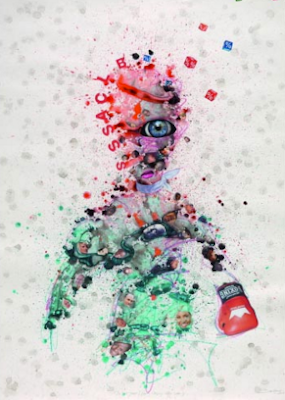Hello from France! First of all, this is my life right now:
Quick trip to the boulangerie!
French Christmas cake, called "bûche de Noël."
More bûche de Noël.
When in France the "sugar can't be in the first three ingredients" school lunch food rule doesn't apply :-) It's been so fun to catch up with family and be back at home.
Yesterday I went to an exhibit of Congolese art at the Cartier Foundation. This is where the Congo is on a map of Africa.
Maybe you've heard of Cartier because of their famous watches. The company also owns a museum in Paris. Since I'm interested in Africa, my grandfather and I decided to head out into the city to learn more about Congolese art.
Before I show you some of the art at the museum, it's important to review our unit on Colonialism. Don't remember much about colonialism? Reread the PowerPoint here. Simply put, colonialism is when a country takes over another country or part of another country. An easy way to remember the reason that countries colonized other countries is "The Three Gs": Glory, God and Gold.
First off, a long time ago, what is now called the Democratic Republic of the Congo, was called The Kingdom of Kongo. The Kingdom of Kongo was colonized by Belgium. Where is Belgium? It's in Europe, it shares a border with France.
Belgium sent soldiers and priests to Africa to take over the Kingdom of Kongo. They ruled over the Kingdom of Kongo for about 75 years. At first, it was ruled by the Belgian King Leopold the II. During this time, he renamed the capital to Leopoldville. He sounds like a bit of an egomaniac naming a city after himself. Let's also remember that Washington D.C. (Washington, District of Columbia) is named after President George Washington and Christopher Columbus, and Columbus also colonized a country. Do you remember which country Columbus colonized...?
The Three Gs for Belgian Congo:
Glory: Belgium took over this country because they wanted more power and glory. All of Western Africa was given to European countries at the Berlin West Africa Conference in 1884.
God:The Congolese schools were run by Christian priests who wanted to spread Christianity to Africa.
Gold: While Congo wasn't famous for its gold, it did bring a lot of money to Belgium through all of the rubber.
Eventually, in 1960, Congo received its independence from Belgium, which means that they weren't under Belgian rule anymore. Yet this was a very hard time as many Congolese weren't given an education under Belgian rule. In 1960, when Belgian soldiers left, only sixteen Congolese people were in college.
Okay now for some art! Understanding the Congolese history of colonialism can help us understand the artwork we're going to look at.
This is a painting of Nelson Mandela and Barack Obama. Do you know who Nelson Mandela is? Read more about him here. Mandela was the first Black president of South Africa and Obama was the first Black president of the United States. What do you think this painting is showing?
Not only were there paintings at the exhibit, there were also a few model cities.
Remember how we made collages, this is a collage!
Photo taken from the Fondation Cartier website.
Okay dear students, it's time for me to get back to family. Look at more Congolese art here (scroll down to the bottom). Have a lovely vacation and I'll write again sometime in the next week!
Devotedly,
Miss Alicia








No comments:
Post a Comment